Cat Grooming Tips – Keep Your Feline Healthy, Clean & Happy
🐾 Introduction
Cats are naturally clean animals, often seen licking their fur and grooming themselves for hours each day. But that doesn’t mean they don’t need your help. Whether you own a short-haired tabby or a long-haired Persian, proper grooming plays a vital role in maintaining your cat’s health, comfort, and happiness. These cat grooming tips are not just about keeping your pet looking pretty—they’re about preventing health issues, reducing shedding, and creating a stronger bond between you and your feline friend.
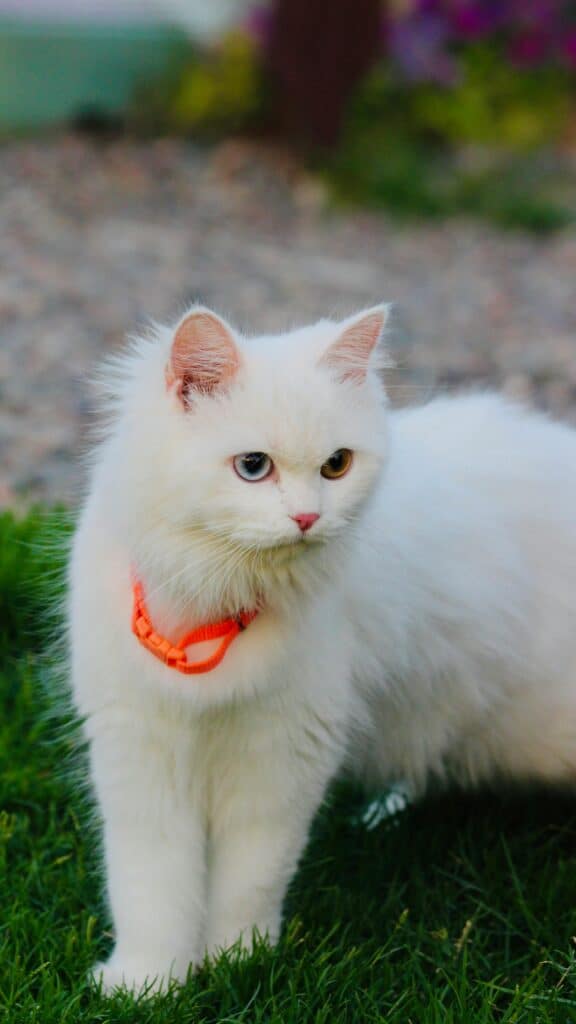
Many cat owners mistakenly believe that grooming is only for show cats or long-haired breeds. In reality, every cat, regardless of coat type or age, benefits from regular grooming. Brushing helps reduce mats and tangles, cleaning the ears and eyes helps avoid infections, and clipping nails prevents painful overgrowth and furniture damage. In fact, grooming your cat regularly is just as important as feeding them nutritious food or providing clean water.
If you’ve ever struggled to bathe your cat without getting scratched, or felt overwhelmed by their constant shedding, you’re not alone. Grooming doesn’t have to be stressful—for you or your cat. With the right tools, techniques, and consistency, grooming can become a peaceful, even enjoyable part of your routine.
In this complete guide, we’ll share the best cat grooming tips trusted by veterinarians and professional groomers. From brushing and bathing to nail trimming and ear care, each section is designed to help you understand what your cat needs and how to do it safely. You’ll also find product recommendations, step-by-step instructions, and tips for grooming anxious or older cats.
Whether you’re a first-time cat parent or looking to improve your existing grooming routine, this guide has everything you need. By the end, you’ll feel confident in handling your cat’s grooming at home—saving time, money, and stress.
So, let’s dive in and discover the easiest ways to keep your cat clean, healthy, and happy—starting with brushing techniques that actually work.
🧼 Tip #1: Brushing Your Cat the Right Way
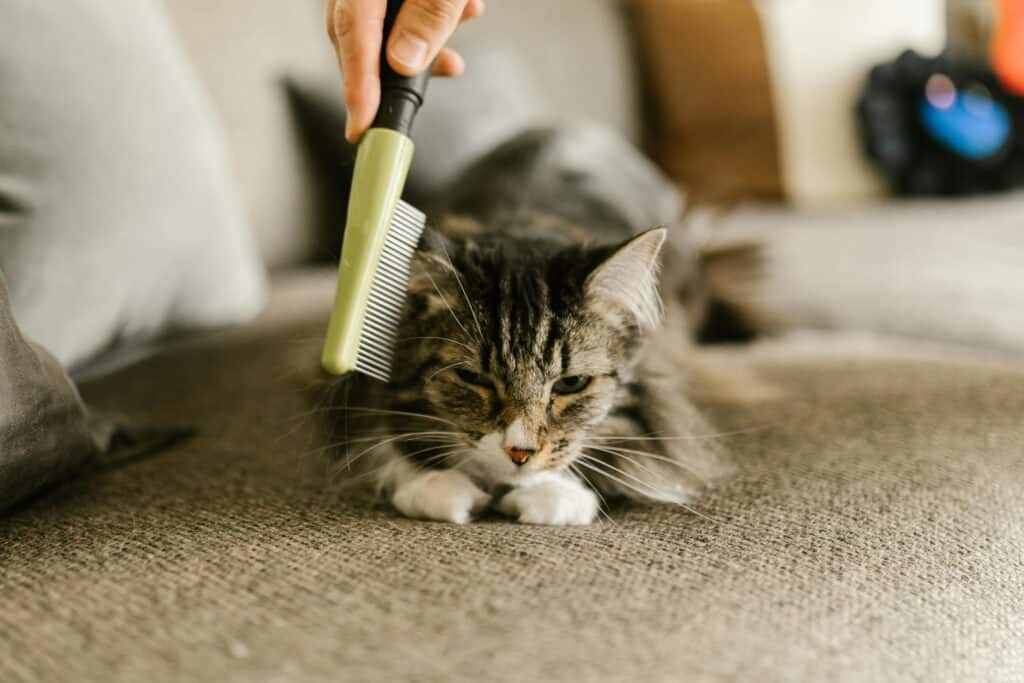
Keep your cat’s coat clean, shiny, and tangle-free
Regular brushing is one of the most important cat grooming tips you can follow, and it’s often the first step toward a healthy grooming routine. Not only does brushing remove dirt, loose hair, and dander, but it also helps distribute natural oils across your cat’s skin, making their coat soft and shiny. Plus, it reduces shedding — a win for your furniture and clothes!
🐱 Why Brushing Matters
Cats shed all year, even more during seasonal changes. Long-haired breeds like Persians or Ragdolls are especially prone to matting, which can lead to painful tangles and skin irritation. But even short-haired cats benefit from weekly brushing, as it prevents hairballs and stimulates blood circulation.
Brushing is also a great opportunity to check for:
- Fleas or ticks
- Skin bumps or scabs
- Hidden wounds or irritations
By making brushing a regular habit, you’re doing more than just grooming — you’re actively protecting your cat’s health.
🧴 How Often Should You Brush?
| Cat Type | Recommended Frequency |
|---|---|
| Short-haired cats | 1–2 times per week |
| Long-haired cats | 3–5 times per week |
| Senior/anxious cats | Gentle brushing as tolerated |
🛠️ Best Brushes for Cats
Choosing the right brush depends on your cat’s coat type. Here are some popular and affordable grooming tools (great for affiliate linking):
- Slicker Brush – Ideal for long-haired cats; removes mats and tangles
- Bristle Brush – Good for short-haired cats and daily touch-ups
- Deshedding Tool – Great during shedding seasons to remove undercoat
🛒 [Insert affiliate product box here – “Top-Rated Cat Slicker Brush on Amazon”]
Make sure the brush has soft or rounded tips to avoid irritating your cat’s skin.
🐾 Tips for a Stress-Free Brushing Session
- Start slow – Let your cat sniff the brush first
- Pick the right time – Brush when your cat is relaxed (e.g., after a nap or meal)
- Use gentle strokes – Always go in the direction of fur growth
- Reward with treats – Positive reinforcement builds trust
If your cat resists brushing, begin with short sessions and gradually increase the time. Stay calm and patient — consistency matters more than perfection.
👁️👂 Tip #2: Cleaning Your Cat’s Ears & Eyes Gently
Keep infections and irritation away with safe, simple cleaning habits
While cats are naturally clean, their ears and eyes still need occasional attention — especially if they’re prone to allergies, breed-specific sensitivities, or spend time outdoors. Regularly checking and gently cleaning these sensitive areas is one of the most overlooked yet essential cat grooming tips.
🧼 Why Clean Your Cat’s Ears & Eyes?
Neglecting these areas can lead to:
- Ear infections
- Mites or wax buildup
- Watery or crusty eyes
- Redness, irritation, or unpleasant odor
By cleaning them regularly, you prevent health issues before they start — and make vet visits far less stressful (and expensive).
👂 How to Clean Your Cat’s Ears Safely
Cats’ ears should be pink, clean, and odor-free. A little wax is normal, but dark brown, black discharge, or bad smell can indicate infection or mites.
✅ Step-by-Step Ear Cleaning:
- Use a vet-approved cat ear cleaner (never use water or alcohol).
- Gently hold your cat in a calm environment — wrap in a towel if needed.
- Apply a few drops into the ear canal (follow product instructions).
- Gently massage the base of the ear for 5–10 seconds.
- Let your cat shake its head (normal behavior).
- Wipe away loosened wax using a cotton pad (not Q-tips inside the ear).
🛒 [Insert affiliate link – “Best Cat Ear Cleaning Drops”]
👁️ How to Clean Cat Eyes
Tear stains, crusty discharge, or watery eyes are common, especially in flat-faced breeds like Persians and Himalayans.
✅ Step-by-Step Eye Cleaning:
- Use soft cotton pads or clean gauze.
- Dampen slightly with lukewarm water or vet-recommended sterile eye wipes.
- Wipe from the inner corner outward — use a separate pad for each eye.
Avoid using human eye drops or any chemical solutions not meant for pets.
🐱 Pro Tips:
- Check ears and eyes once a week during grooming
- Avoid strong scents or harsh products
- If redness or swelling persists, consult your vet immediately
✂️ Tip #3: Nail Clipping Without Stress
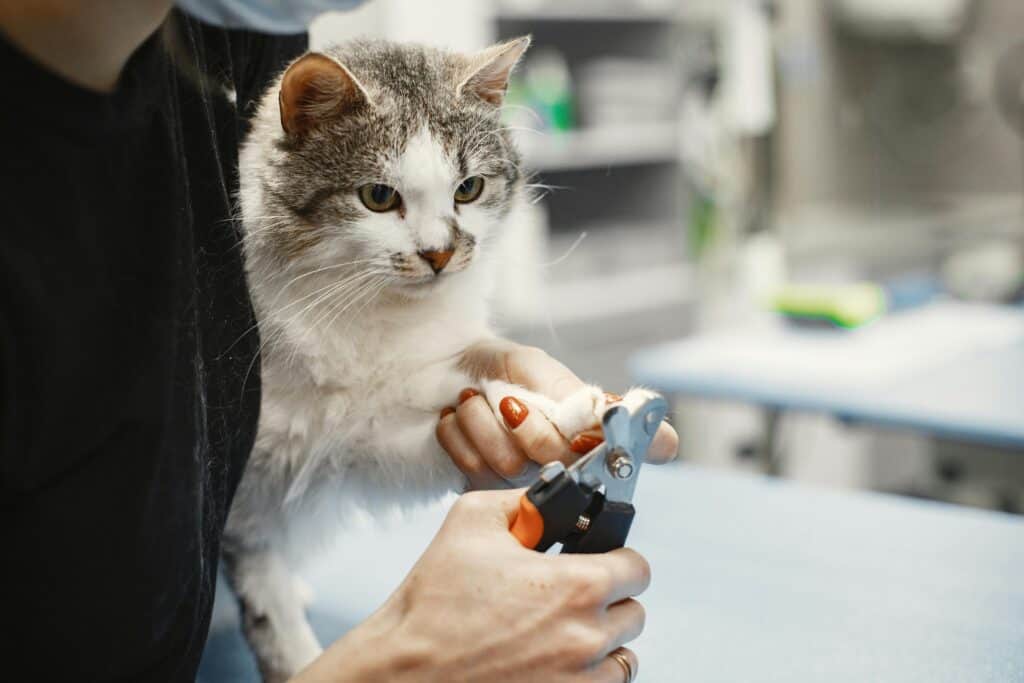
Protect your cat, your furniture, and yourself with proper nail care
Nail trimming is one of the most important yet nerve-wracking cat grooming tips for many pet parents. Left untrimmed, your cat’s nails can become overgrown, curl into the paw pads, or cause scratches on your skin and furniture. The good news? With the right tools and a calm approach, you can trim your cat’s nails safely and stress-free.
🐾 Why Is Nail Trimming Important?
- Prevents painful overgrowth
- Reduces accidental scratching
- Stops furniture/clothing damage
- Protects your cat from nail infections or split claws
Indoor cats may not wear down their nails naturally, especially if they don’t use scratching posts regularly. That’s why routine trimming is essential.
🛠️ What You’ll Need:
- Cat nail clippers (scissor or guillotine style)
- Styptic powder (in case of accidental bleeding)
- Towel (to gently wrap anxious cats)
- Treats (to reward calm behavior)
🛒 [Insert affiliate product: “Safe Cat Nail Clippers with Safety Guard”]
✅ Step-by-Step: How to Trim Your Cat’s Nails
- Pick the right moment – Choose a calm time (after nap or play session)
- Wrap your cat gently – Use a towel to swaddle if needed
- Expose one paw – Press the pad lightly to extend the claws
- Trim only the clear tip – Avoid cutting the pink “quick” (blood vessel inside)
- Do 1–2 paws per session – Don’t rush or force a full trim if your cat resists
- Praise and reward – Offer a treat or cuddle after
❗ If you accidentally cut the quick, use styptic powder to stop bleeding
😺 Tips for Success:
- Trim nails every 2–4 weeks
- Get your cat used to paw handling early
- Use positive reinforcement — treats go a long way
- Stay calm — your cat will sense your energy
If you’re too nervous to do it yourself, many groomers or vet clinics offer quick, affordable nail trims.
🧹 Tip #4: Dealing With Cat Shedding
Keep your home fur-free and your cat comfortable year-round
No matter how much you love your cat, finding fur on your couch, clothes, and even your food isn’t ideal. Shedding is a normal part of a cat’s life, especially during seasonal changes. But with the right approach, you can reduce excessive shedding, keep your cat’s coat healthy, and your home much cleaner. These cat grooming tips are especially helpful for multi-cat households or allergy-sensitive families.
🐱 Why Do Cats Shed?
Cats shed to get rid of old or damaged fur. While indoor cats may shed year-round, outdoor or seasonal exposure can trigger more intense shedding during spring and fall. Long-haired breeds like Maine Coons or Himalayans usually shed more than short-haired cats.
Excessive shedding, however, could be a sign of:
- Poor diet
- Stress or anxiety
- Allergies or skin conditions
- Lack of grooming
That’s why regular grooming isn’t just cosmetic — it’s preventive care.
✅ Tips to Control and Reduce Shedding
1. Brush Regularly
Use the right brush based on your cat’s coat:
- Deshedding tools for thick undercoats
- Rubber brushes for short-haired cats
Brush 3–5 times per week for long-haired breeds and at least once a week for short-haired cats.
🛒 [Insert affiliate link: “Best Deshedding Brush for Cats – Vet Approved”]
2. Improve Your Cat’s Diet
Poor-quality food leads to dry skin and weak hair, which increases shedding. Look for cat food rich in:
- Omega-3 & Omega-6 fatty acids
- Protein from real meat
- No artificial fillers or preservatives
You can also add supplements like fish oil (with vet approval) to support a healthy coat.
3. Hydration & Humidity
Dehydration can cause flaky skin and hair loss. Always keep fresh water available. In dry climates, use a humidifier indoors to prevent dryness in your cat’s skin.
4. Lint Rollers & Fur Control Hacks
Keep lint rollers handy on furniture and clothes. You can also try:
- Anti-shedding wipes
- Fur-resistant blankets
- Pet vacuums with special filters
🧰 Bonus: Must-Have Cat Grooming Tools You Should Own
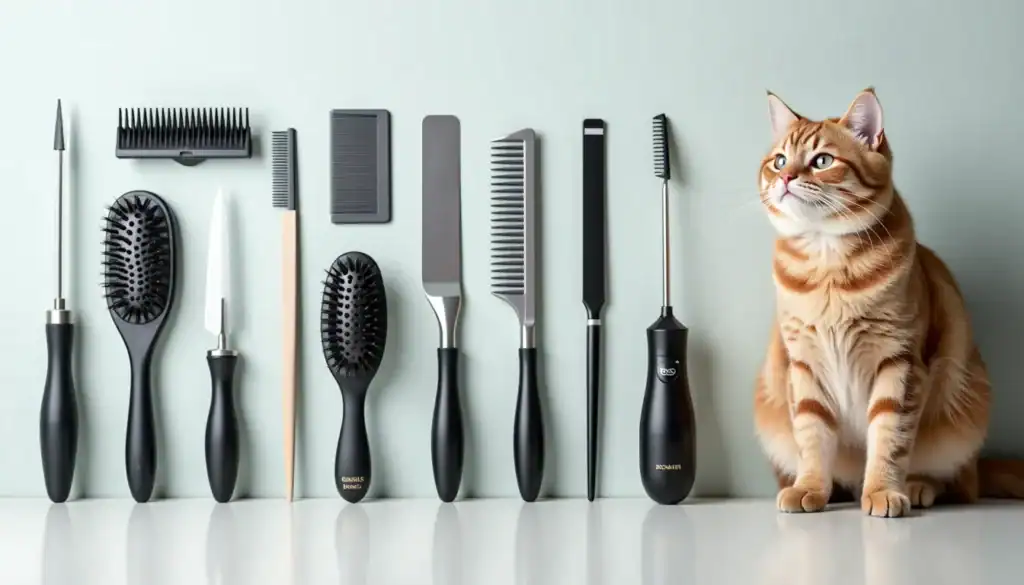
The right tools make cat grooming easier, safer, and more effective
A well-groomed cat isn’t just about routine — it’s also about using the right tools. Most cat grooming tips recommend investing in high-quality products like brushes, nail clippers, and deshedding tools. Whether you’re brushing, trimming nails, or managing shedding, these essential tools can save you time, effort, and even vet visits. Some links may be affiliate-based — please read our Affiliate Disclaimer for transparency.
These tools are gentle, affordable, and designed for home grooming. In this section, we’ll break down the essential cat grooming tools that every cat parent should have.
🪮 1. Slicker Brush
Ideal for long-haired breeds like Persians or Ragdolls, a slicker brush removes tangles, mats, and loose hair with fine wire bristles.
🛒 [Affiliate Link: Best Slicker Brush for Cats – Soft & Skin-Friendly]
Use this anchor text: “Best slicker brush for long-haired cats”
🖐️ 2. Rubber Grooming Glove
Perfect for short-haired cats, this glove turns petting into grooming. It removes loose hair and stimulates natural oil production without stressing your cat.
🛒 [Affiliate Link: Cat Grooming Glove – Massage & Deshedding in One]
✂️ 3. Cat Nail Clippers
Choose clippers with a safety guard and ergonomic grip. Guillotine or scissor styles are both effective.
🛒 [Affiliate Link: Safe Nail Clippers with Safety Lock for Cats]
Internal Link Suggestion:
➤ Link to your blog (in future): “How to Trim Cat Nails at Home”
💧 4. Ear Cleaner Solution
A mild, vet-approved ear cleaning solution helps remove wax buildup and prevents infections. Look for non-alcohol formulas with soothing ingredients.
🛒 [Affiliate Link: Vet-Approved Cat Ear Cleaner – Alcohol-Free]
🧼 5. Pet Wipes or Eye Pads
Gentle grooming wipes help clean around eyes, ears, and fur. Great for senior cats or post-surgery hygiene.
🛒 [Affiliate Link: Hypoallergenic Grooming Wipes for Cats]
Alt text for image:cat grooming tools and wipes✅
🪒 6. Deshedding Tool (Furminator-type)
A must-have during shedding seasons. It safely removes the undercoat without damaging topcoat fur.
🛒 [Affiliate Link: Deshedding Tool for Cats – Ideal for Seasonal Shedding]
Anchor text: “Best cat deshedding tool”
🧴 7. Cat Shampoo (Optional)
If your cat needs occasional baths, always use shampoo formulated for cats (never dog or human shampoo).
🛒 [Affiliate Link: Gentle Cat Shampoo – Tear-Free & Fragrance-Free]
🛠️ Pro Grooming Kit Tip:
You can also buy a complete grooming kit that includes brushes, clippers, wipes, and combs. These are great for beginners and come in budget-friendly bundles.
🛒 [Affiliate Link: Complete Cat Grooming Kit – 7-in-1 Set]
Alt text for image:full grooming kit for cats✅
❓ Frequently Asked Questions (FAQs)
Q1. How often should I groom my cat?
It depends on your cat’s breed and coat. Short-haired cats benefit from once or twice a week, while long-haired cats may need more frequent care. According to most cat grooming tips, brushing, nail checks, and ear cleaning should be part of your regular routine.
Q2. Can I use human grooming products on my cat?
No. Most cat grooming tips warn against using human shampoo, wipes, or scissors. Always choose cat-safe products to avoid irritation or harm.
Q3. What’s the best brush for grooming a cat?
That depends on your cat’s coat type. Long-haired cats do well with slicker brushes, while short-haired breeds benefit from rubber grooming gloves. These tools are staples in most cat grooming tips shared by vets and groomers.
Q4. Do indoor cats need grooming too?
Yes! Many indoor cats shed heavily or suffer from nail overgrowth. Cat grooming tips emphasize that indoor cats need regular brushing, nail trims, and ear checks just like outdoor cats.
Q5. How can I reduce my cat’s shedding?
Consistent brushing and a healthy diet are the top cat grooming tips to control shedding. Using deshedding tools and feeding omega-rich food helps keep their coat healthy.
🐾 Conclusion: Mastering Cat Grooming Tips for a Healthier Pet
By now, you’ve seen how small habits and the right tools can make a huge difference in your cat’s overall health. Whether you’re brushing away loose fur, cleaning their ears, or trimming their nails, following expert-backed cat grooming tips can make your grooming routine easier and more effective.
Make grooming a calm, loving activity. Be patient, stay consistent, and always use safe, cat-specific products. These cat grooming tips aren’t just about hygiene — they’re about showing your cat the care they deserve.
Incorporate these cat grooming tips into your weekly routine, and you’ll notice fewer hairballs, less furniture fur, and a much happier, healthier cat. 🐱💛
🐾 Conclusion: Make Cat Grooming a Loving Habit
Grooming your cat is more than just a chore — it’s a form of care, love, and bonding. Whether you’re brushing away loose fur, trimming nails, or cleaning delicate ears, each grooming session helps keep your cat healthy, happy, and comfortable. These cat grooming tips aren’t just about appearance — they’re about wellness and prevention.
Start small, stay consistent, and use the right tools to make the process smooth and enjoyable. With a few minutes of regular grooming each week, your feline friend will look better, feel better, and love you even more for it.
And remember — every swipe of the brush, every clean paw, and every clipped nail is a step toward a healthier, happier cat. 🐱💛


Naeem – Founder, ShopeePets
Helping pet lovers choose the best with honest product reviews, practical advice, and trusted guidance for every pet owner.
Visit ShopeePets.com →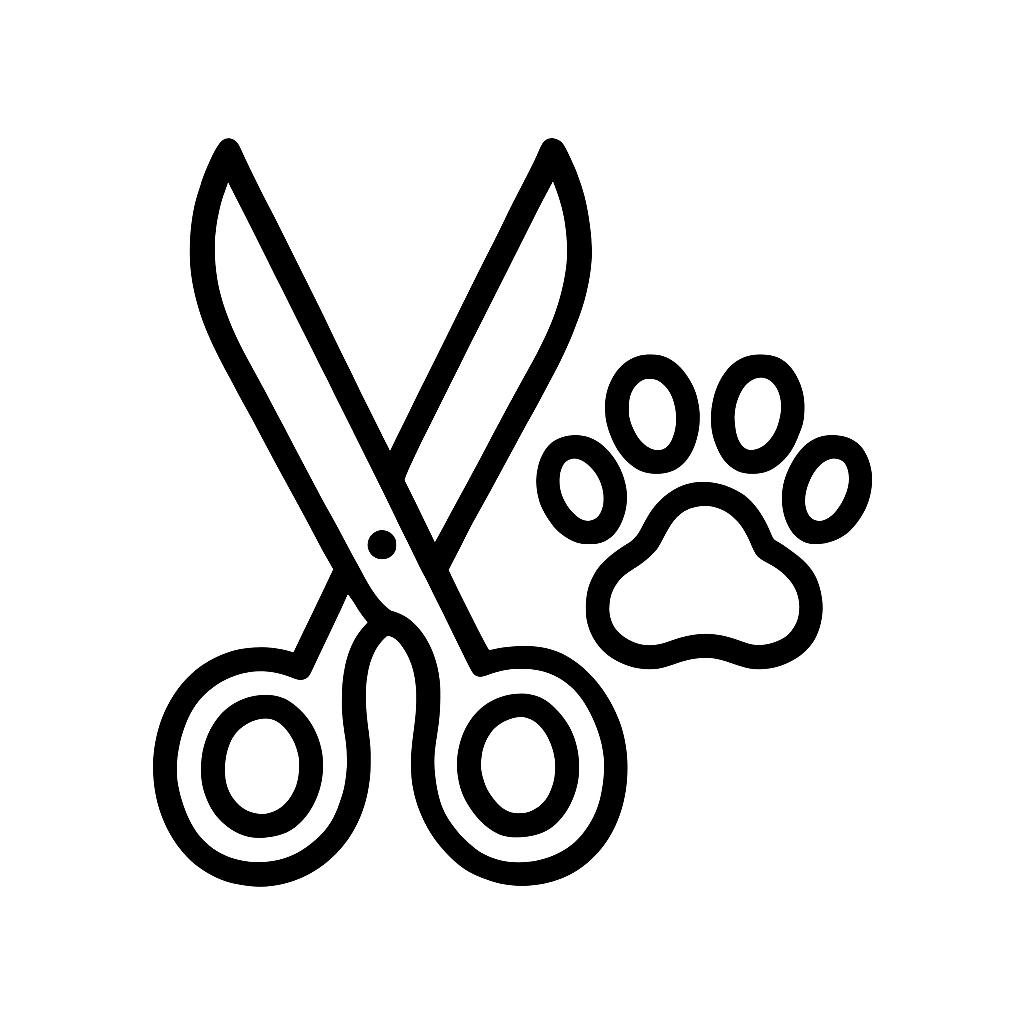






Shopeepet is the best pet care advicer